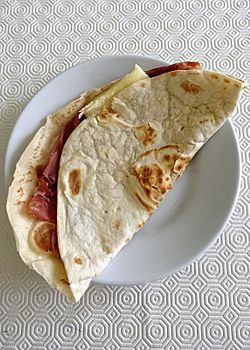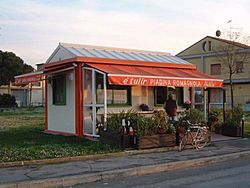Piadina facts for kids
 |
|
| Alternative names | Piada |
|---|---|
| Type | Flatbread |
| Place of origin | Italy |
| Region or state | Romagna |
| Main ingredients | Flour, lard or olive oil, salt, water |
Piadina (say "pyah-DEE-nah") or Piada (say "PYAH-dah") is a delicious, thin Italian flatbread. It comes from the Romagna region in Italy, which includes cities like Forlì, Cesena, Ravenna, and Rimini.
This tasty bread is usually made with white flour, lard or olive oil, salt, and water. Long ago, people cooked it on a special clay dish called a teggia. Today, most people use flat pans or electric griddles to cook it. Piadina is so special that it's officially listed as a traditional food product of the Emilia-Romagna Region in Italy!
Contents
Where Does Piadina Come From?
Piadina is very popular in the Romagna region of Italy. This includes areas around Forlì, Cesena, Rimini, and Ravenna. You can also find it in nearby places like Montefeltro, the Pesaro e Urbino province, and even the small country of San Marino.
What Does the Name "Piadina" Mean?
The exact meaning of the word "piadina" is a bit of a mystery. Many people think "piada" (which is another name for it) comes from a Greek word for focaccia, another type of flatbread. Others believe the name came from different languages because similar flatbreads were eaten across the large Byzantine Empire.
The famous Italian poet Giovanni Pascoli helped make "Piada" an official Italian word. He changed the local Romagnol word "piè" to "Piada." The Romagna region was once part of the Byzantine Empire, which might explain how this Greek-Byzantine recipe became a local favorite.
The first time Piadina was written about was in 1371. A cardinal named Anglico described it as "bread of the people of Romagna." He wrote that it was made with wheat flour, water, salt, milk, and a little lard.
Piadina Today: How It's Eaten

Today, you can often buy Piadinas fresh from special small shops called piadinerie. These shops usually fill them with lots of yummy things. Popular fillings include different kinds of cheeses, cold meats, and vegetables.
You can also find sweet Piadinas filled with jam or even Nutella! The way Piadina is made can be a little different depending on where you are. For example, Piadinas from Ravenna and Forlì are usually thicker. Those from Rimini and the Marche region are often thinner and wider.
Piadina has even traveled to space! A Russian astronaut ate it as part of a healthy Mediterranean diet experiment on the International Space Station.
The poet Giovanni Pascoli once said that "Nothing speaks more of Romagna than this bread of ours... it is a symbol that speaks of devotion to our land." This shows how important Piadina is to the people of Romagna.
See also
 In Spanish: Piadina para niños
In Spanish: Piadina para niños

